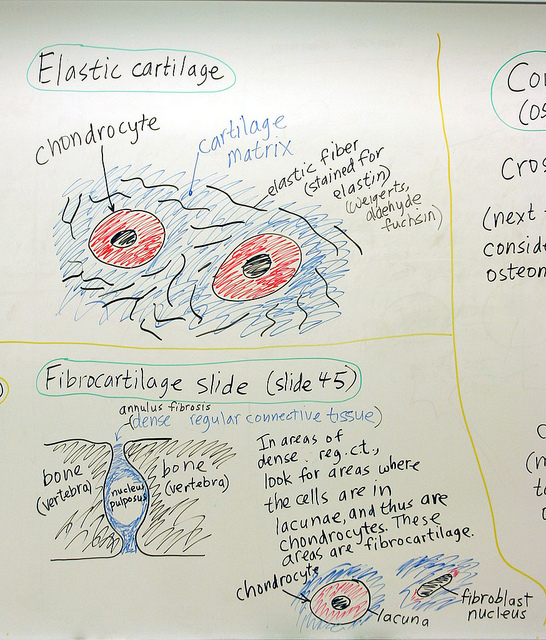Difference Between Chondrocytes and Osteocytes
Key Difference – Chondrocytes vs Osteocytes
Connective tissues are involved in the connection and separation of different types of tissues and organs and supporting them. It is considered to be one of the four types of tissues present in the living system. Out of different types of connective tissues, bones and cartilage are two important connective tissues with regard to shape and movement of organisms. Bone is a hard structure that forms the skeletal system of the body whilst cartilage is less rigid and is present in the regions such as ear, nose and joints (ends of bones). Chondrocytes are involved in the maintenance of cartilage and osteocytes are involved in the maintenance of bone tissue. This is the key difference between Chondrocytes and Osteocytes.
CONTENTS
1. Overview and Key Difference
2. What are Osteocytes
3. What are Chondrocytes
4. Similarities Between Chondrocytes and Osteocytes
5. Side by Side Comparison – Chondrocytes vs Osteocytes in Tabular Form
6. Summary
What are Osteocytes?
Osteocytes are a type of bone cells present in mature bone tissues. Osteocytes are developed in the mucoid connective tissue. The size of a cell body of an osteocyte may vary from 5-20 micrometers in diameter. A mature osteocyte consists of a single nucleus which is situated on the vascular side and one or two nucleoli may be present along with a membrane. Osteocyte consists of a reduced endoplasmic reticulum, mitochondria and Golgi apparatus and cell processes which radiate towards the matrix.

Figure 01: Osteocytes
There are about 42 billion osteocytes in an average human body. These cells contain an average half-life of 25 years. Osteocytes do not divide but, they are derived from osteoprogenitors. These osteoprogenitors may later differentiate into active osteoblasts. The osteocytes inhabit in spaces called lacunae and the cells in developing stages exist in canaliculi. Once the osteoblasts are trapped inside the matrix, they develop into osteocytes. Osteocytes are interconnected and networked to each other through long cytoplasmic extensions. Osteocytes are said to be inert when compared to other cells in the body. They are able to carry out molecular synthesis, modification, and distant signal transmission; thus, their functions are similar to the nervous system. Majority of the important receptor activities in bone function are carried out in mature osteocytes. Osteocytes are considered as a major regulator of bone mass and an endocrine regulator of phosphate metabolism. Osteocyte death is caused due to necrosis, senescence, apoptosis or engulfment of osteoclasts. Osteocyte destruction may, therefore, cause osteoporosis.
What are Chondrocytes?
Chondrocytes are the only cells present in healthy cartilage. The cartilaginous matrix is produced and maintained by chondrocytes. Collagen fibers and proteoglycans mainly reside in the matrix. Chondroblasts which are also called mesenchymal progenitor cells form chondrocytes through endochondral ossification.
There are 4 main chondrocytic lineages. From least- to terminally-differentiated, the chondrocytic lineage is:

Figure 02: Chondrocytes
The Mesenchymal stem cells have the ability to differentiate into various generative cells which are called osteochondrogenic cells. Initially, when this is taken place in mesenchymal stem cells, they lose their ability to differentiate into any of the three germ layers: endoderm, mesoderm or ectoderm. Then the chondrocytes start to proliferate and densely aggregate where the chondrification process is taking place. The chondrocytes which differentiate to chondroblasts gives rise to the cartilaginous extracellular matrix. Here, the chondroblast is a mature chondrocyte which is inactive but still has the ability for secretion and degradation of the matrix under different conditions. When the chondrocyte becomes hypertrophic (increase the volume of a tissue or an organ as a result of the enlargement of component cells), they go through terminal differentiation which occurs during endochondral ossification.
What are the Similarities Between Chondrocytes and Osteocytes?
- Both osteocytes and chondrocytes are originated from mesenchymal stem cells.
- Both types help the body to recover from the bone fracture.
- Both cells have a great potential to be used for bone tissue engineering.
What is the Difference Between Chondrocytes and Osteocytes?
Chondrocytes vs Osteocytes | |
| Osteocytes are a type of bone cells present in mature bone tissues. | Chondrocytes are a type of cells present in healthy cartilage |
| Function | |
| Osteocytes are involved in the maintenance of bone tissue. | Chondrocytes are involved in the maintenance of cartilage. |
Summary – Chondrocytes vs Osteocytes
Cartilage and bone are considered as two important types of connective tissues. Osteocytes and chondrocytes are the cells of bone and cartilage, respectively. They originate from mesenchymal cells. Osteocytes are developed in the mucoid connective tissue and a mature osteocyte contains a single nucleus. Chondrocytes are involved in the maintenance of cartilage. The cartilaginous matrix is produced and maintained by chondrocytes. Osteocytes are involved in the maintenance of bone tissue. This is the difference between Chondrocytes and Osteocytes.
Download PDF Version of Chondrocytes vs Osteocytes
You can download PDF version of this article and use it for offline purposes as per citation notes. Please download PDF version here Difference Between Chondrocytes and Osteocytes
Reference:
1. Aarden, Elisabeth M., et al. “Function of osteocytes in bone.” Journal of Cellular Biochemistry, Wiley Subscription Services, Inc., A Wiley Company, 19 Feb. 2004, Available here. Accessed 8 Sept. 2017
2. Muir, H. “The chondrocyte, architect of cartilage. Biomechanics, structure, function and molecular biology of cartilage matrix macromolecules.” BioEssays : news and reviews in molecular, cellular and developmental biology., U.S. National Library of Medicine, Dec. 1995, Available here. Accessed 8 Sept. 2017
3. “Osteocytes and chondrocytes embedded in bone matrix control bone remodelling.” BoneKEy reports, Nature Publishing Group, 2012, Available here. Accessed 8 Sept. 2017.
Image Courtesy:
1. “Transverse Section Of Bone” By BDB – Gray’s Anatomy of the Human Body from the classic 1918 publication available online at Bartleby.com. Coloured and modified using Adobe Illustrator. (CC BY-SA 2.5) via Commons Wikimedia
2. “Cartilage and Bone: Elastic Cartilage” by Dr. A. Kent Christensen (CC BY-SA 2.0) via Flickr
ncG1vNJzZmivp6x7pbXFn5yrnZ6YsqOx07CcnqZemLyue8OinZ%2Bdopq7pLGMm5ytr5Wau26vx6ilnaqfmMa1sdJmmKecXavAbrvSrZyom6mpsrR7